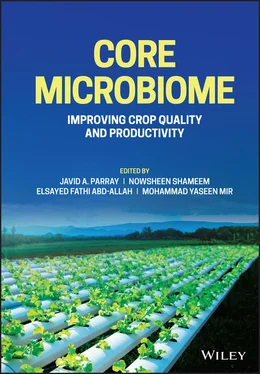122 122 Mercier, J. and Manker, D.C. (2005). Biocontrol of soilborne diseases and plant growth enhancement in greenhouse soilless mix by the volatile-producing fungus Muscodor albus. Crop Protection Apr 1 24 (4): 355–362.
123 123 Zheng, M., Shi, J., Shi, J., Wang, Q., and Li, Y. (2013). Antimicrobial effects of volatiles produced by two antagonistic Bacillus strains on the anthracnose pathogen in postharvest mangos. Biological Control May 1 65 (2): 200–206.
124 124 Wan, M., Li, G., Zhang, J., Jiang, D., and Huang, H.C. (2008). Effect of volatile substances of Streptomyces platensis F-1 on control of plant fungal diseases. Biological Control Sep 1 46 (3): 552–559.
3 Impact of Microbiomes to Counter Abiotic Stresses in Medicinal Plants- A Review
Abeer Hashem1,2, Khaloud Mohammed Alarjani1, Khalid F. Almutariri3, Javid A. Parray4, Sushil K. Sharma5, Ashwani Kumar6, Turki M. Dawoud1, Khalid S. Almaary1, Nosheen Shameem7, and Elsayed Fathi Abd-Allah3
1 Botany and Microbiology Department, College of Science, King Saud University, P.O. Box. 2460, Riyadh 11451, Saudi Arabia
2 Mycology and Plant Disease Survey Department, Plant Pathology Research Institute, ARC, Giza, Egypt
3 Plant Production Department, College of Food and Agricultural Sciences, King Saud University, P.O. Box. 2460, Riyadh 11451, Saudi Arabia
4 Department of Environmental Science, Higher Education Department, Government Degree College, Eidgah, Srinagar, India
5 ICAR-National Institute of Biotic Stress Management, Baronda, Raipur – 493 225, Chhattisgarh, INDIA
6 Metagenomics and Secretomics Research Laboratory, Department of Botany, Dr. Harisingh Gour University (A Central University), Sagar – 470003, Madhya Pradesh, India
7 Department of Environmental Science, Cluster University, Srinagar – 190001, Jammu & Kashmir, India Corresponding author. Abeer Hashem, Botany and Microbiology Department, College of Science, King Saud University, P.O. Box. 2460, Riyadh 11451, Saudi Arabia.
Medicinal plants are a major group of crops that are considered very valuable due to their role in helping people maintain good health. These medicinal plants are traditionally used as herbal formulations for the prevention and treatment of diseases (Williamson 2003). About 80% of the world’s population depends on medicinal herbs directly or indirectly as reported by the World Health Organization (Kasilo and Trapsida 2010). These medicinal plants are associated with many beneficial bacteria. The microbes have a positive and antagonistic effect with other microbes in the soil. Moreover, the rhizosphere biome helps plants grow as well as manage pathogenic microorganisms residing in the rhizosphere ruthlessly to break the protective shield and overwhelm the innate plant defense mechanism (Hashem et al. 2017; Dubey et al. 2019.
Bioactive phytochemicals were the focus of previous medicinal plant research, however, because to the realization that a considerable number of phyto-therapeutic chemicals are really created by related microorganisms or through contact with their host, the focus is currently moving. The host rhizosphere, a narrow zone of the soil contains more than 30,000 prokaryotic species and a large number of microbial cells in a one-gram root (Berendsen 2012). These are attracted by rhizosphere plant root secretion and deposits into the soil. Among all microbes, Bacillus and Pseudomonas are well-known genera that are used to produce organic biofertilizers and improve soil fertility and biogeochemical cycles for better growth of the entire plant (Freitas et al. 2004). The tolerance and secondary metabolites mechanism for commercial medicinal plants has not been investigated. So, there is a need to determine the response of medicinal plants under stress conditions, as salt stress reduced the quality of essential oils and secondary metabolites in medicinal plants. Both biotic and abiotic stresses are significant constraints in agriculture production, which is affected by several factors such as hormonal and nutritional imbalance, ion toxicity, physiological disorders, and susceptibility to disease (Dubey et al. 2018; Malla et al. 2018).
In this study, we discuss plants and microbes and their interaction with the microbiomes and implications of abiotic stresses toward medicinal plant response; physiological, biological, and molecular mechanisms; and microbe-mediated stress-alleviation processes. Less information is available for the molecular mechanism of metabolites in medicinal plants. Modern omics approaches, i.e. quantitative trait loci, functional genomics techniques, proteomics, and mass spectrometry, are used to understand plant–microbe interactions to optimize under abiotic stresses (Kumar and Dubey 2020).
3.2 Structure and Function of Microbiota
Plant rhizosphere contains microorganisms including bacteria, algae, fungi, actinomycetes, and protozoa, among which bacteria are important contributors in the rhizosphere (Kaymak 2010). Actinomycetes belong to filamentous bacteria (gram positive) with a high guanine–cytosine ratio in their DNA, and they are good sources of natural compounds used in the pharmaceutical industry (Golinska et al. 2015). Endophytic actinomycetes showed enhanced growth and decreased disease infestation through the production of bioactive secondary metabolites. Some important bioactive compounds that are released by host plants and their therapeutic properties along with microorganisms are presented in Table 3.1. Moreover, they alter plant physiology by stimulating the acquired resistance in medicinal plants. Specific antibiotics produced by genera of Penicillium , Trichoderma , Aspergillus , and Actinomycetes may enhance producer diligence when competitors or predators are present in soil habitats. Moreover, Azospirillum, Gluconacetobacter , Pseudomonas , and Rhizobium , Bacillus , and Paenibacillus and gram-positive genera are also included in this circle. Plant–microbe mutualism produces diverse biochemical mechanism that improves bacterial health and ultimately plant growth (Bulgarelli et al. 2013). It also enables plants to maintain microbiota in the soil. The concentration of the bacteria found around the roots of plants is greater than the rest of the soil. It might also be due to the presence of nutrients including sugars, amino acids, and organic acids as well as other small molecules from plant root exudates that fix one-third of carbon by the plant (Badri et al. 2009). However, it mostly depends on soil type and host genotype interaction. Both the type and number of bacteria found in different soils are influenced by soil conditions. It was also influenced by soil temperature, moisture, chemicals as well as the concentration of the salts, and the number and types of crop plants present in the soil. Moreover, the effect of specific bacterium on the plant may change with the change of conditions. For example, a bacterium facilitates plant growth either by fixing phosphorus compounds or by fixing nitrogen that benefits only plants (Kumar et al. 2015, 2016). Plants with medicinal properties, their use, and secondary metabolites production under abiotic stress condition are presented in Table 3.1.
Table 3.1 Plants with Medicinal Properties Under Abiotic Stress, Their Use, and Their Secondary Metabolites.
| Medicinal plants |
Uses |
Secondary metabolites |
Abiotic stresses |
References |
| Pluchea lanceolata |
Bronchitis, dyspepsia, and rheumatoid arthritis |
Quercetin |
Heavy metals |
Kumar et al. (2004) |
| Dioscorea bulbifera |
Antispasmodic, analgesic, aphrodisiac, and diuretic |
Diosgenin |
Metal |
Narula et al. (2005) |
| Catharanthus roseus |
Cancer and diabetes mellitus |
Vinblastine |
Salinity |
Jaleel et al. (2009) |
| Jatropha curcas |
Skin diseases and rheumatism, piles |
Curcin |
Salinity |
Gao et al. (2008) |
| Orthosiphon stamineus |
Antiallergenic, antihypertensive, anti-inflammatory, and nephritis |
Polyphenols |
Salinity |
Ting et al. (2009) |
| Thymus maroccanus Ball |
Antitussive, antiseptic, antispasmodic, and antihelmintic |
Thymol |
Salinity |
Belaqziz et al. (2009) |
| Matricaria chamomilla |
Mucositis and irritable bowel syndrome |
Umbelliferone |
CuCl 2 |
Eliasova et al. (2004) |
| Bacopa monnieri |
Antioxidant, epilepsy, and asthma |
Bacoside |
Salinity and Drought |
Debnath et al. (2011) |
| Olea europaea L. |
Antipruritic, antiseptic, astringent, and cholagogue |
Oleosides |
Salinity |
Rejskova et al. (2007) |
| Populus euphratica |
Anodyne, anti-inflammatory, febrifuge, and vermifuge |
Gallic acid |
Salinity |
Zhang et al. (2004) |
| Matricaria chamomilla |
Sore stomach, irritable bowel syndrome, and oral mucositis |
Apigenin |
Salinity |
Razmjoo et al. (2008) |
| Ziziphora clinopodioides |
Antibacterial and sedative stomachache |
Leucoanthocyanins |
Salinity and Defoliation |
Koocheki et al. (2008) |
| Dioscorea dregeana |
Sedative and anti-inflammatory |
Paclobutrazol |
Smoke, temperature |
Kulkarni et al. (2007) |
| Datura innoxia |
Anodyne, antispasmodic, hallucinogenic, hypnotic, and narcotic |
Scopolamine |
Light, dark, and HCHO deprivation |
Laszlo et al. (2004) |
However, the composition of the secondary metabolite, which is common in the rhizosphere belongs to these bacteria, such as actinobacteria, bacteroidetes, firmicutes, and proteobacteria. Microbial communities provide protection directly or indirectly from the pathogen in the leaf regions while root microbiota provides an additional host function by getting nutrients from the soil. Other functions of the microbiota associated with these medicinal plants such as phytohormone production, nutrient solubilization, and nitrogen metabolism are also important (Kumar et al. 2015).
Читать дальше











